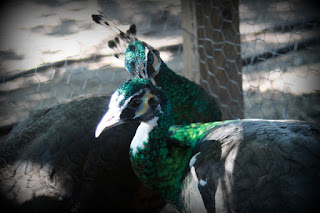 |
| Heckle & Jeckle |
The Peacock does not mature until he is around 3 years old. This is when his train (tail) becomes long and full. The train or tail can reach 6 feet in length and make up about 60% of it's body length, and is made of more than 200 feathers. His wings will be a streaked brown and white design. He will use his train in an effort to impress the girls! However, they remain mostly uninterested with the exception of a short period of time in which they are ready to breed. This happens at around 2 years of age for the girls. It's best to only have around four Peahens to each Peacock. The breeding season typically lasts from around April until late summer (August -September), at which time the male will molt and lose his tail and the fertility rate drops. This ends the breeding for that season. He then slowly begins to grow a new train and by the next March - April it is full and pretty again. Each year the tail grows longer and fuller.
After breeding, the hens will lay an egg a day for around a week to ten days and then they will sit on the eggs to hatch them. If the eggs are gathered daily, hens may continue to lay for up to a month. Peafowl eggs are much too scarce and valuable to be eaten. Incubation is an option for the gathered eggs. They need to be kept at a temperature of 99.9 degrees for 28 days. The chicks must then be kept in a brooder at a temperature of 95 degrees for the first week and dropped by 5 degrees per week until they are at room temperature. Most peachicks can fly within days of birth. If bred in captivity and allowed to raise the chicks, peahens might raise three clutches per year. Clutches vary in size and range from four to 10 eggs with 8 being the average. It is said that chicks raised naturally by the hen are smarter and healthier, but chicks incubated and handled a lot are much tamer and friendlier.
Peafowl are long lived with wild peafowl living up to 20 years and domesticated peafowl having been known to live for 40 to 50 years. There are two popular species of Peafowl, the India Blue, and the Greens. There are 15 known colors of peafowl. As a side note, I thought one of my early ones might be a peacock because at a young age it would fan it's tail. In researching, I found that the females also fan their tails. Their tails are just not a pretty as the males.
 Heckle will still come to me to eat meal worms from my hands. She will jump in my lap if I allow it. Jeckle will come to me but wants her worms on the ground. She is a bit more shy. My other two girls still prefer that I throw them their worms a little distance from my feet. Of course non of them can reach me for Heckle. I still go in daily to feed them meal worms and work on keeping them tame. We are currently planning a large aviary outside their pen for them to be able to get out and enjoy the sun and for others to be able to enjoy their beauty when they pass our farm.
Heckle will still come to me to eat meal worms from my hands. She will jump in my lap if I allow it. Jeckle will come to me but wants her worms on the ground. She is a bit more shy. My other two girls still prefer that I throw them their worms a little distance from my feet. Of course non of them can reach me for Heckle. I still go in daily to feed them meal worms and work on keeping them tame. We are currently planning a large aviary outside their pen for them to be able to get out and enjoy the sun and for others to be able to enjoy their beauty when they pass our farm. 

No comments:
Post a Comment